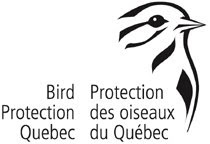Eleven birders travelled in a convoy of five cars through the flat wind-swept spaces in the St-Clet/Ste-Marthe/Ste Justine area looking for open country winter birds. Although tolerable, driving conditions were extremely tricky with winds increasing in intensity throughout the morning causing drifting snow and iced over roads. Snow flurries added to the visibilty problems. Passing an overturned vehicle on Highway 201 shortly after our departure emphasized the need for caution. Nevertheless we were able to complete our planned route.
Our first few stops of the morning were at feeders most notably one on Chemin St-Emmanuel near St-Clet. This major feeding station attracts a very large number of birds and it was here that we had our bird of the day - Wild turkeys. An impressive group of 76 or probably more were in the immediate vicinity and probably only the arrival of our cars kept the majority from actually using the feeders. As it was a half dozen of them still made a quick stop for breakfast before running off to join their friends. The feeders also produced redpolls, goldfinches, juncos, tree sparrows, blue jays, mourning doves, an impressive number of hairy and downy woodpeckers, chickadees, nuthatches, a lone pine siskin and just as we arrived a dozen snow buntings.
Much of the remainder of the morning was spent scouring the open countryside in a vain attempt to locate snowy owls, gray partridge and other target birds. Sightings of snowies have been few and far between this winter in the area and conditions were not conducive to aiding in our search. However we did end up with excellent views of snow buntings, lapland longspurs and horned larks, many of them at feeders. A particularly productive station was near the corner of Ste-Julie and Mtee Ste-Julie. A mixed flock containing over 100 snow buntings and 30-40 lapland longspurs was dividing its time between the feeders and a nearby cornfield. Having these active birds actually remain stationary at a feeder allowed for detailed looks through the scope.
All in all, considering the conditions of the day, it was a successful trip. That said, those who stayed home because they felt uncomfortable with the potential driving conditions probably made a wise choice as that part of the outing was not enjoyable.
Our complete list of 21 species included: American Black Duck - 2 (open section of the river in St-Polycarpe), Wild Turkey - 76+, Rock Pigeon - 150, Mourning Dove - 6, Downy Woodpecker - 3, Hairy Woodpecker - 8, Blue Jays - 12, American Crow - 20, Commomn Raven - 1, Horned Lark - 30, Black-capped Chickadee - 10, White-Breasted Nuthatche - 2, European Starling - 40, American Tree Sparow - 24, Dark-eyed Junco - 24, Lapland Longspur - 50, Snow Bunting - 200+, Common Redpoll - 40, Pine Siskin - 1, American Goldfinch - 6, House Sparrow - 20
Canard noir - 2 (rivière à St-Polycarpe), Dindon sauvage - 76 +, Pigeon biset - 150, Tourterelle triste - 6, Pic mineur - 3, Pic chevelu - 8, Geai bleu - 12, Corneille d'Amérique - 20, Grand corbeau- 1, Alouette hausse-col - 30, Mésange à tête noire - 10, Sittelle à poitrine blanche - 2, Étourneau sansonnet - 40, Bruant Hudsonien- 24, Junco ardoisé - 24, (Plectrophane lapon (Bruant lapon) - 50, (Plectrophane des neiges (Bruants des neiges) - 200 +, sizerin flammé - 40, Tarin des pins - 1, Chardonneret jaune - 6, Moineaux domestiques - 20
Thanks to everyone who came out and braved the conditions - Wayne Grubert
Subscribe to:
Post Comments (Atom)





No comments:
Post a Comment